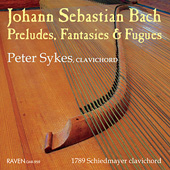
ESSENTIAL RECORDINGS

1} Prelude, Fugue and Allegro in E-flat major, BWV 998
2} Fantasy on a Rondo in C minor, BWV 918
3} Praeludium and Fughetta in G major, BWV 902
4} Prelude and Fugue after Albinoni in B minor, BWV 923/951
5} Fantasy and Fugue in A minor, BWV 904
6} Chromatic Fantasy and Fugue in D minor, BWV 903
Johann Sebastian Bach's music has been jazzed up (Swingle Singers, Jacques Loussier), it's been rocked up (RDM - Il Rovescio Della Medaglia
- an Italian progressive rock band), it's been supersized (orchestrations by Leopold Stokowski), it's been used to terrify (the original movie version of the
Phantom of the Opera), it's been elevated (Glenn Gould), it's been promoted as psychedelia (Virgil Fox at Fillmore), and it's been used, reused and transformed
in countless ways, including the famous or infamous accounts by Wendy/Walter Carlos on the Moog Synthesizer which, by the way, happens to sound very
much like the clavichord used in this new recording. But to hear the true, unadorned Bach you have to hear his music played on an instrument that he himself
would have used to write his music.
In this new Raven recording, organist Peter Sykes, better known for his groundbreaking (and ground shaking) recording
of "The Planets" by Gustav Holst on a monster of a pipe organ, performs these pieces on a clavichord built in 1789 by Johann Christoph Georg Schiedmayer. It's
a single keyboard instrument that spans about three octaves, and like most clavichords, is rather monochrome in color. But that's the point. On an instrument
as basic as this, the musician has to make every note count. The harmonic and contrapuntal interaction of the notes really stands out here, as does the clarity
of the melody and counter melodies. The player has to shape and color the music in order to reveal its expressive qualities, and Peter Sykes
delivers on all counts. The slightest little blemish can also stand out clearly on a clavichord, and besides a few dynamic imbalances from one key to the next here
and there, it's clear sailing. What matters here, and what Sykes achieves, is the revelation of Bach's wisdom behind each and every musical phrase. It makes clear the fact
that when Bach composed and/or played his music on instruments like this one, he wasn't out to impress, but rather to let the music speak for itself.
In this day and age of bigger, faster and louder, it's nice to hear music like this unfold naturally, and sound original and true to its roots.
Jean-Yves Duperron - July 2014